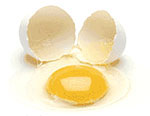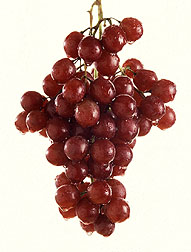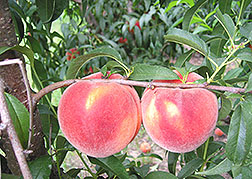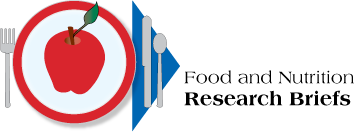| October 2004 |
Vitamin D's Possible Link to Good Gum Health Probed
Getting enough vitamin D, from the foods you eat and from sunlight, could help your oral health, new findings suggest. A study funded in part by the Agricultural Research Service and reported in the American Journal of Clinical Nutrition (2004, vol. 80, pp. 108-113) showed that participants who had higher levels of an indicator of vitamin D in their blood serum had better periodontal health than those participants with lower levels of the biomarker, known as 25-hydroxy vitamin D3. The study, conducted by researchers at the ARS Jean Mayer USDA Human Nutrition Research Center on Aging at Tufts University, and their colleagues, encompassed data from 11,202 men and women aged 20 and up who participated in the third National Health and Nutrition Examination Survey. Eighty percent of the participants had lower-than-desired vitamin D levels. The scientists suspect that vitamin D, in ways not yet determined, cuts down on the inflammatory response that could otherwise lead to periodontal disease. A chronic inflammatory condition, periodontal disease is marked by loss of attachment of the thin ligaments that connect teeth with their surrounding bone sockets Egg yolks, liver and fatty fish such as salmon are naturally rich in vitamin D. Milk and some breakfast cereals are fortified with this essential nutrient; sunlight stimulates our skin to make it. For more information, contact Bess Dawson-Hughes, (617) 556-3064; ARS Jean Mayer USDA Human Nutrition Research Center on Aging at Tufts University, Boston, MA. What Do We Eat in America? Survey Helps Researchers Find OutThe most authoritative source of information about what Americans eat is now available on the World Wide Web. What We Eat In America, NHANES 2001-2002 is posted at https://www.ars.usda.gov/ARSUserFiles/80400530/pdf/0102/wweia_2001_2002_data.pdf 
This comprehensive resource integrates federal nationwide food consumption data from the Agricultural Research Service's food consumption survey, known as What We Eat in America, with data from the National Health and Nutrition Examination Survey, or NHANES, conducted by the U.S. Department of Health and Human Services. ARS scientists at the Beltsville (Md.) Human Nutrition Research Center worked with their NHANES counterparts to integrate the surveys. Previously, both federal surveys were conducted periodically. The integrated survey will be conducted every year. Researchers analyze the data to spot and report key eating patterns that could impact our health. Policymakers also rely on the data as a resource when they are developing food assistance and nutrition education programs. For more information, contact Alanna J. Moshfegh, (301) 504-0170; USDA-ARS Beltsville Human Nutrition Research Center, Beltsville, MD. Lutein-Enriched Eggs--A Superb Source of This Carotenoid
Our bodies are better able to absorb eye-healthy lutein from eggs than from other food source of this carotenoid. That's according to a study funded by ARS and the Egg Nutrition Center in Washington, D.C. (August 2004, Journal of Nutrition, vol. 134, pp. 1887-1893). Scientists working at Tufts University, Boston, Mass., conducted the research. They suspect that egg-yolk compounds such as lecithin enhance lutein's bioavailability. Low lutein intake is a risk factor in age-related macular degeneration, the leading cause of vision loss among older Americans. Lutein and a related carotenoid, zeaxanthin, can accumulate within the macula--part of the retina--and imparts a yellow pigment that helps protect the eye. During four separate test phases, volunteers consumed sources of lutein that provided 6 milligrams a day of the carotenoid. By the end of the study, all volunteers had consumed cooked spinach, two different types of lutein supplements, and specially enriched eggs that provided five times more lutein than that found in conventional eggs. When volunteers ate eggs as the source of lutein, their lutein blood serum levels--tested before and after the meal--were about three times greater than after consuming the same lutein dose from the other sources. The new findings suggest eggs can be an important source of highly bioavailable lutein. However, the researchers caution that eating more than one egg a day could provide higher-than-recommended amounts of cholesterol. For more information, contact Elizabeth J. Johnson, (617) 556-3204; ARS Jean Mayer USDA Human Nutrition Research Center on Aging at Tufts University, Boston, MA. Grapes' Pterostilbene Helps Lower Lipids
Pterostilbene (pronounced TAIR-oh-STILL-bean), a natural compound in grapes that has already been shown to fight cancer, may also lower lipids. Lipid-lowering compounds can help fight heart disease and alleviate some of the health problems associated with obesity. In a study using rat liver cells, ARS and university scientists compared the lipid-lowering effects of pterostilbene to that of ciprofibrate, a drug used for controlling lipids, and resveratrol, a grape compound with a chemical structure similar to that of pterostilbene. They based their comparison on each compound's ability to activate PPARa, short for peroxisome proliferator-activated receptor alpha. Activation leads to lowering of lipids in the blood. Pterostilbene outperformed resveratrol and was as effective as ciprofibrate in activating PPARa. The ARS scientists and other colleagues had, in earlier work, detected pterostilbene for the first time in berries of some Vaccinium species, including cranberries and blueberries. For more information, contact Agnes M. Rimando, (662) 915-1037; USDA-ARS Natural Products Utilization Research Unit, Oxford, MS. Boosting the Flavor of Reconstituted Orange Juice
Freshly-squeezed orange juice owes its delightful taste and aroma to more than 40 natural compounds. ARS investigations of these compounds are determining the level, or threshold, at which we can smell or taste them in the juice. That information, in turn, can be used to create better "flavor packs" for reconstituted juice, giving the product more of that delicious, fresh-squeezed taste. Flavor packs contain the aroma compounds that are stripped off when freshly squeezed juice is evaporated to make a condensed juice that's easier and cheaper to transport or to store as frozen concentrate. Juice-processing companies buy flavor packs, adding their contents to frozen, concentrated juice--along with water--before marketing their reconstituted product. Now, ARS studies with volunteer "taste-testers" should improve the quality of those packs. Florida growers annually harvest an average of more than 200 million 90-pound boxes of oranges. About 80 percent of the oranges are processed, mostly into juice. For more information, contact Elizabeth A. Baldwin, (863) 293-4133; USDA-ARS Citrus and Subtropical Products Laboratory, Winter Haven, FL. Levels of Healthful Proanthocyanidins Documented in Database
ARS' new proanthocyanidin database provides a convenient listing of the levels of these healthful, natural antioxidants present in some 206 selected foods and beverages, including fruits, nuts, and even chocolate. Proanthocyanidins are of ongoing interest to nutrition and health researchers because of their potential health benefits. For instance, proanthocyanidins may be associated with reduced risk of cardiovascular diseases, cancer and other illnesses. Scientists with ARS' Beltsville Human Nutrition Research Center collaborated with scientists at the Arkansas Children's Nutrition Center, Little Rock, Ark.; Mars, Inc., of Hackettstown, N.J.; and Ocean Spray Cranberries, Inc., of Lakeville, Mass., to prepare the new database available. It's available on the World Wide Web at: https://data.nal.usda.gov/dataset/usda-database-proanthocyanidin-content-selected-foods-release-2-2015 The compilation is based on data from existing scientific literature as well as newer data from food-sample analyses conducted by the Arkansas researchers. For more information, contact Joanne M. Holden, (301) 504-0630; USDA-ARS Beltsville Human Nutrition Research Center, Beltsville, MD. Free-Range Chicken Not Immune From Salmonella
Salmonella levels in free-range chickens may not be significantly different from those of conventionally-produced birds, according to an Agricultural Research Service study. That means you need to use the same care in handling either kind of poultry at home, making sure the meat is thoroughly cooked. A foodborne pathogen, Salmonella can cause diarrhea, fever and abdominal cramps. It's commonly transmitted in undercooked or uncooked poultry or other foods. Food safety scientists at ARS' Richard B. Russell Research Center, Athens, Ga., examined 110 processed, free-range chickens from three organic producers and found that about 25 percent of the chickens tested positive for Salmonella. Conventionally-raised chickens had somewhat higher levels of the microbe than the free-range birds. For more information, contact J. Stan Bailey, (706) 546-3356; USDA-ARS Richard B. Russell Research Center, Athens, GA. Ruby Queen Plum, Scarletprince and Julyprince Peaches Developed for You.Two splendid new peaches and a luscious new plum have been developed by plant breeders at the ARS Southeastern Fruit and Tree Nut Research Laboratory in Byron, Ga., for planting in commercial orchards and backyards of the southeastern United States. Initial supplies of budwood have been made available to researchers, breeders and commercial nurseries. 
Scarletprince and Julyprince peaches are round and large--almost 3 inches in diameter. The fruit of both varieties, especially that of Julyprince, softens slowly while on the tree, meaning it can be picked over a longer period than comparable varieties. That allows needed flexibility and helps ensure a more even supply of freshly harvested fruit for shoppers. Scarletprince, ripe and ready to pick in late June through early July, has more bright red on its skin than Julyprince, which also largely bright red but has more of its attractive, bright-yellow undercolor showing through. The yellow, freestone flesh of Scarletprince is sweet and flavorful, with an excellent texture. Julyprince peach ripens in early to mid-July. Its great-tasting, freestone flesh is yellow with some red coloring near the pit. A high-quality, late-ripening plum, Ruby Queen did well in orchard tests in central Georgia, New Jersey and New York--and is recommended for testing in other areas with similar climates. This juicy plum ripens in mid- to late July at Byron. No other plums suitable for the Southeast are available to ripen at that time. Ruby Queen has dark-red to reddish-black skin, with firm red flesh and outstanding flavor. The fruit is round--about two inches in diameter--and is high in antioxidants. For more information, contact William R. Okie, (478) 956-6405; USDA-ARS Southeastern Tree Nut and Fruit Laboratory, Byron, GA. What Helps Our Bodies Capture Iron?
Some compounds promote iron uptake, thus helping our bodies capture iron from the foods we eat. ARS scientists and their co-investigators are tracking these compounds. They're doing that with a human cell culture system that mimics natural digestion, and sophisticated laboratory techniques for separating compounds into their component fractions. Meat is already known to have an iron-promoting factor, for instance, and human milk is thought to have one, as well. But the biochemical or biochemicals that perform this role in human breast milk haven't been determined. To learn more, the scientists compared three major groups of components in human and cow's milk--casein, fat and whey. Their tests indicated that breast-milk whey apparently enhances iron uptake; fat may hinder it, and casein has no effect. In contrast, cow's milk whey and fat apparently don't affect iron uptake, but it's casein seems to act as an iron-uptake inhibitor. In follow-up studies, the researchers want to pinpoint the exact components in breast-milk whey that promote iron uptake. The work may pave the way to improving bioavailability of this essential nutrient from a wide range of foods. For more information, contact Raymond P. Glahn, (607) 255-2452; USDA-ARS U.S. Plant, Soil and Nutrition Research Laboratory, Ithaca, NY. "Squire's Quest" Game Improves Kids' Eating Habits
Elementary school kids who played a nutrition-based computer game called "Squire's Quest" begin eating an extra serving of a fruit, juice or vegetables within 5 weeks, the game's developers have found. That's impressive, because educational programs can sometimes take up to two years to achieve a similar goal. And, the game brings these children a step closer to getting the recommended five servings a day of fruits and veggies. In testing the game, scientists based at the Children's Nutrition Research Center, Houston, Texas, split 1,578 fourth-graders in the Houston Independent School District into a participating group and a control group, comparing records of what the kids ate during the four days before and after the start of the 10-session game. Scientists structured the fantasy game to award points to the students who prepare a simple, fun, fruit- or veggie-based recipe at home; eat an additional serving of a fruit, juice or veggie at a meal or snack; or ask for a favorite fruit, juice or vegetable to be more readily available at home. For more information, contact Thomas Baranowski, (713) 798-6762; USDA-ARS Children's Nutrition Research Center, Houston, TX. Product Labels Don't Always Measure Up, Study Shows
Diabetics and other people on strict food regimens might want to weigh packaged foods before eating them, instead of relying on the weights printed on the label, results of an Agricultural Research Service experiment suggest. Scientists measured the actual weight of 99 different single-serving-sized, commercially-packaged foods such as breakfast cereals and canned fruit. Their intent? To see if they could rely on those weights in providing precisely-measured meals to volunteers in nutrition research studies. Only 37 food items were found to be statistically accurate. Fifteen items were below weight, making them potentially out of compliance with federal guidelines; and 47 products contained more food than advertised. The September 2004 issue of the Journal of the American Dietetic Association has details (vol. 104, pp. 1420-1424). For more information, contact Joan M. Conway, (301) 504-8977; USDA-ARS Beltsville Human Nutrition Research Center, Beltsville, MD. |
|
The United States Department of Agriculture (USDA) prohibits discrimination in all its programs and activities on the basis of race, color, national origin, gender, religion, age, disability, political beliefs, sexual orientation, and marital or family status. (Not all prohibited bases apply to all programs.) Persons with disabilities who require alternative means for communication of program information (Braille, large print, audiotape, etc.) should contact USDA's TARGET Center at (202) 720-2600 (voice and TDD). To file a complaint of discrimination, write USDA, Director, Office of Civil Rights, Room 326-W, Whitten Building, 14th and Independence Ave., SW, Washington, DC 20250-9410 or call (202) 720-5964 (voice or TDD). USDA is an equal opportunity provider and employer. |

